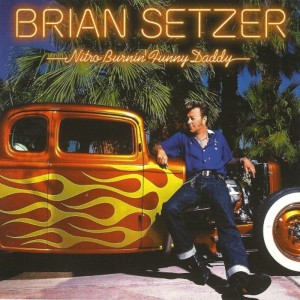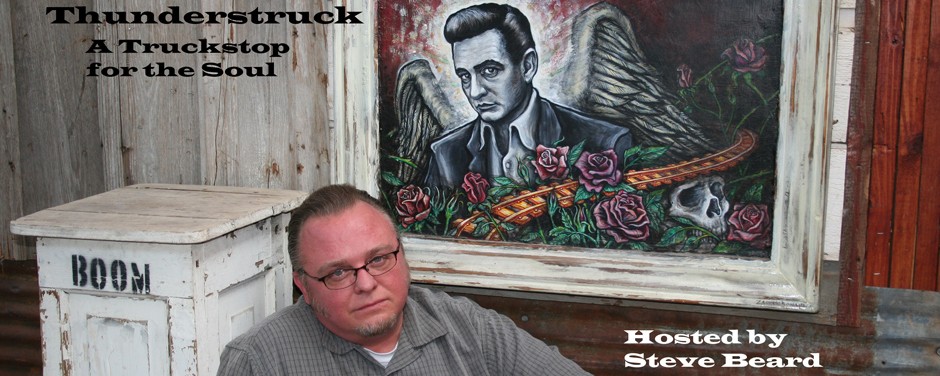
Guitarist-singer Brian Setzer plays with his orchestra June 29, 2006 in the East Room of the White House, during the entertainment following the official dinner in honor of Japanese Prime Minister Junichiro Koizumi’s visit to the United States. White House photo by Eric Draper.
By Steve Beard
January 7, 2004, National Review
In the early 1980s, Stray Cats front man Brian Setzer stood up in the moshpit of the punk-rock/new-wave revolution and daringly waved a big, greasy flag for rockabilly. Reviving 1950s-inspired rock ‘n’ roll was far more defiant than it may seem. After all in the mainstream-music world, Ozzy was biting off bat heads, The J. Giles Band was scoring with “Centerfold,” and radio was hooked on “Maneater” from Hall and Oates.
 Nevertheless, Setzer captured the imagination of the freshman class of the emerging MTV generation with his peroxide pompadour, pleated baggies, patent leather Creepers, and his 1959 Gretsch guitar strapped over his leather clad shoulder. Joined by fellow bandmates Slim Jim Phantom and Lee Rocker, Setzer had hits with “Rock This Town,” “Runaway Boys,” and “Stray Cat Strut.”
Nevertheless, Setzer captured the imagination of the freshman class of the emerging MTV generation with his peroxide pompadour, pleated baggies, patent leather Creepers, and his 1959 Gretsch guitar strapped over his leather clad shoulder. Joined by fellow bandmates Slim Jim Phantom and Lee Rocker, Setzer had hits with “Rock This Town,” “Runaway Boys,” and “Stray Cat Strut.”
Ten years later, he directed his revivalist mojo to the sounds of swing and big-band rock. When the Brian Setzer Orchestra launched in the early 1990s, the music scene was captivated by grunge acts such as Pearl Jam and the gansta rap of Dr. Dre.
Undaunted, Setzer turned heads with his audaciously ambitious guitar-led 17-piece band–an idea inspired by watching Doc Severinsen’s orchestra on The Tonight Show hosted by Johnny Carson. Setzer’s hipster big-band sound (and his fetching back-up singers) caught on and his sold-out shows became one of the hottest tickets in town. It also garnered Setzer a handful of well-deserved Grammy Awards.
His 2002 Boogie Woogie Christmas album turned out to be a huge hit and Setzer gave Harry Connick Jr. a run for his money as the hippest holiday crooner. The album features a seven-minute swinging version of Tchaikovsky’s “The Nutcracker Suite” and is further graced with a duet on “Baby It’s Cold Outside” with actress Ann-Margaret. In December, Setzer and his orchestra were booked for seven national TV appearances in the three weeks prior to Christmas-even performing at the tree lighting ceremony at Rockefeller Center in New York City.
His 2004 album, Nitro Burnin’ Funny Daddy, returned Setzer to his stripped-down roots. The album is kicked off with the gritty roadhouse “Sixty Years,” written shortly after the death of his close friend Joe Strummer of the Clash. “Saint Peter didn’t put you here/ For no reason at all/ So when it’s time to go/ Oh brother stand tall,” Setzer sings. “This is the most personal album I’ve ever done,” Setzer has confessed. “Lyrically, I go into areas I’ve never touched before–relationships, spirituality. I just wanted to let my whole life out, more than just the hot-rod rockabilly side.”
With the death of Strummer, as well as that of Joey Ramone, Setzer began thinking more about mortality and the brevity of life, figuring that hard-living rock ‘n’ rollers were only given about 60 years before they met their Maker.
In addition to the standard rockabilly formula of whiskey, hotrods, and stiletto-heeled women, Setzer daringly touches upon his spiritual underpinnings on the song “St. Jude”–a prayerful meditation to the patron saint of the impossible, lost causes, and the doomed. In the song, he describes spirituality as “scorned from the left/ And abused by the right/ It’s something so misunderstood/ And ignored in daily life.”
Setzer goes on to affirm his convictions: “If you proclaim the mystery of faith/ You’ll be absolved from daily strife/ Through Him, in Him, and within Him/ Springs our eternal life.”
With the exception of singing “O Holy Night” on his Christmas album, this kind of song was new terrain for the guitar impresario. As with so many other musicians, the September 11 terrorist attack sparked a willingness to grapple with the kind of transcendent issues that are either scorned or often put on the back burner in rock ‘n’ roll.
“I hate to say anything about 9/11, because everybody exploits the hell out of that,” Setzer has pointed out, “but we’ve been hearing all kinds of stuff about what we should do: we should beat people up, we shouldn’t beat people up, we should do this, that, and the other thing…but how about prayer? I believe in prayer; I never let that out in a song before, but it’s true. And sometimes it’s the most important thing you can do.”
On “St. Jude,” Setzer sings, “Spirituality is a thing of the past/ And it’s something that money can’t buy.”
“Seems to me that’s true,” he told the Desert Sun. “You’ve got MTV and Howard Stern and shock jocks who make fun of religion. It’s something to be derided almost, and nobody seems to say anything about it. I’m shocked by that. I’m shocked by the lack of respect for spirituality and religion.”
“I’m a religious person,” he states matter-of-factly. “I’m a Catholic. But I think any kind of spirituality is good. My chosen spirituality is Catholicism and I believe in Jesus.
“Now, if I was to say that in Rolling Stone, it would probably either get edited out or there would be some snide comment about that. And that’s what I was talking about in a song like (“St. Jude”): How spirituality or religion is almost something people deride. A lot of the reason is because of the caricatures of religion, people like Jimmy Swaggart, Jim Bakker. Young people see that and say, ‘This is a joke.’ A lot of it is the fault of these people and a lot of it is the fault of the whole left-wing journalism of Spin magazine or Rolling Stone. It’s not ‘cool.’
“I’m just saying I think it’s a wrong thing to be poking fun at. There should be some respect of people’s spirituality and/or religion.”
The heavily tattooed and hot-rod loving Setzer would certainly seem to be an unlikely crusader for Christian spirituality, traditional values, and prayer. Not surprisingly, however, his outspoken musings offer provocative food for thought. But no one should be surprised. After all, he has been blessed with a 20-year career of swimming upstream and making old things new again with fresh pizzazz and style.
Steve Beard is the creator of Thunderstruck.Org and a contributing author to Spiritual Journeys: How Faith Has Influenced Twelve Music Icons. This article appeared on National Review Online on January 7, 2004.

Pingback: Happy Birthday Brian Setzer! |